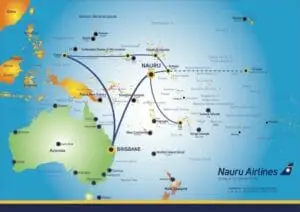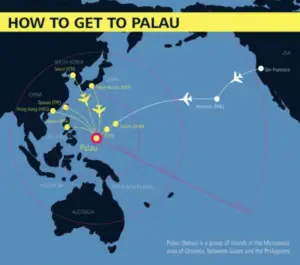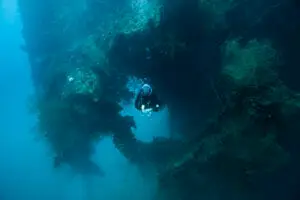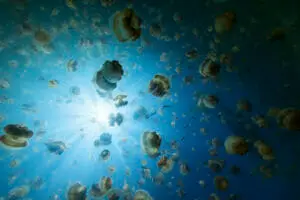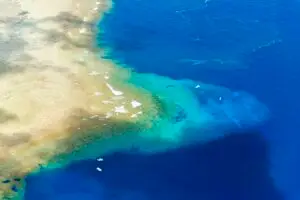Where Coral Grows on Steel: Palau’s WWII Wreck Legacy
Palau is one of the most celebrated dive destinations in the world. Its outer reefs are legendary—drift dives along Blue Corner, swirling barracuda tornadoes, manta rays in German Channel.
But for those who look deeper, there’s another side to Palau that many divers miss: a world of rusted steel, sunken history, and coral-covered wartime ghosts.
Beneath the calm, clear lagoons of Palau lies an underwater museum. Dozens of World War II wrecks—ships, planes, submarines—rest silently on the seafloor, slowly being reclaimed by nature.
They’re frozen moments from a time of chaos, transformed into living reefs filled with life and color. Gun turrets are now draped in soft corals. Propeller shafts are overrun with oysters and sponges. Where soldiers once stood, lionfish now patrol.
Wreck diving in Palau isn’t just about exploration. It’s about connection—to history, to the sea, and to stories still unfolding.
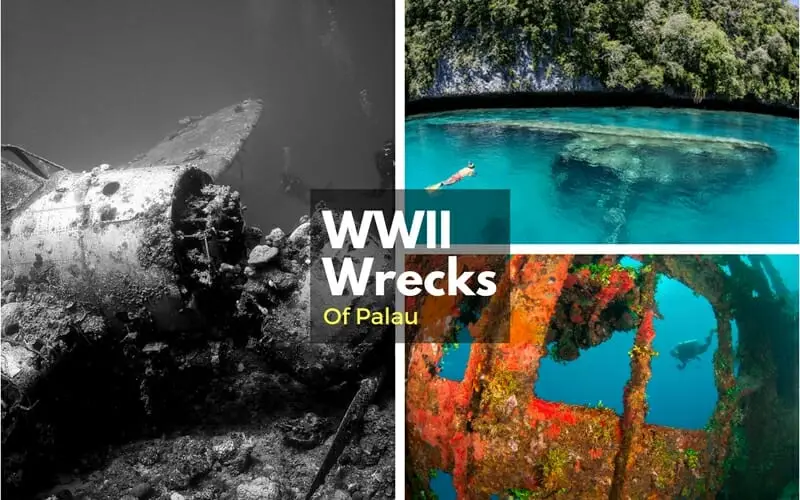
Table of Contents
Why Palau Is a World-Class WWII Wreck Diving Destination
If you’re searching for wreck diving that’s rich in history, alive with marine life, and accessible to recreational divers—you’ve found it.
Here’s why Palau stands out:
Unrivaled Historical Significance: The waters of Palau are home to more than 30 diveable WWII wrecks. These aren’t artificial reefs or scuttled ships—they’re real wartime casualties, preserved almost exactly where they fell in 1944.
World-Class Visibility: Visibility here can reach up to 40 meters, especially during dry season. That means you can take in the full scale of a 470-foot warship without ever losing sight of your buddy.
Warm Water Year-Round: With temperatures ranging from 27°C to 30°C (81°F to 86°F), you can dive in comfort without thick suits or cold-water conditions.
Diverse Marine Life: Over decades, the wrecks have become blooming artificial reefs. Expect to see hard and soft corals, anemones, nudibranchs, giant clams, lionfish, octopuses, reef fish, and even the occasional shark or turtle.
Dives for Every Skill Level: Whether you’re new to wrecks or an experienced penetration diver, Palau has something for you—from shallow seaplane wrecks in 15 meters to massive cargo ships resting in 40 meters of water.
And perhaps most of all: Palau’s wrecks are uncrowded. While other destinations may have boats lined up at the mooring lines, here you often have the wrecks to yourself—with your guide, your buddy, and 80 years of history.
👉 Want to turn this dream into reality? Browse our dive packages here and let’s start planning your adventure.
And when you’re not diving, Palau has just as much to offer above the surface—from island hikes to cultural sites and scenic lookouts. Explore Palau’s top points of interest here.
How WWII Shaped Palau’s Underwater Landscape
During WWII, Palau was a key military base for the Japanese Empire. With its central location in the Pacific and protected lagoons, it served as a vital supply and communication hub.
Japan heavily fortified the islands—especially Koror, Peleliu, and Angaur—building airfields, bunkers, and anchoring a fleet in the calm lagoon.
In 1944, as the U.S. pushed west across the Pacific, Palau became a major target.
Operation Desecrate One
On March 30–31, 1944, American forces launched a massive air assault from aircraft carriers of Task Force 58. The attack was swift and devastating.
Planes dropped bombs, torpedoes, and naval mines into Palau’s anchorages, sinking dozens of Japanese vessels in a matter of hours.
The result? A graveyard of cargo ships, tankers, and patrol boats settled across the seafloor, many of them still intact today.
Operation Snapshot & Stalemate II
In the months that followed, U.S. forces launched reconnaissance missions and prepped for invasion. In September, they landed on Peleliu and Angaur to secure the islands ahead of General MacArthur’s return to the Philippines.
The Battle of Peleliu became one of the bloodiest battles in the Pacific, marked by ferocious resistance and heavy casualties. While most of the land battle’s legacy is found topside on Peleliu, the waters around the Rock Islands still hold the scars of these operations.
After the War
Following Japan’s surrender, many wrecks were partially salvaged in the 1940s and ’50s, especially those close to the surface or holding valuable metals. But dozens were left untouched—too deep, too damaged, or forgotten.
Then, in the 1970s and 1980s, as scuba diving in Palau began to flourish, local pioneers and international explorers started rediscovering them. More recently, teams like Project Recover have continued the work, using sonar, drones, and underwater ROVs to locate lost aircraft and missing-in-action service members.
And so, today, Palau’s waters hold something truly rare: an entire fleet of WWII wrecks, preserved by time, accessible to divers, and slowly becoming one with the reef.
Wreck Diving Sites in Palau: Shipwrecks You Shouldn’t Miss
From massive war freighters to delicate seaplanes, Palau’s WWII wrecks each have their own story—and their own feel underwater. Some are giants resting in the deep. Others lie just beneath the surface, wrapped in soft coral and sunlight. Some you’ll glide over. Others you’ll swim through.
Below, you’ll find a handpicked list of the most iconic, accessible, and visually stunning WWII wrecks in Palau—complete with history, marine life, and dive details for each one.
Let’s start with the one that started it all…
Iro Maru – The Pride of Palau’s Wreck Diving
If there’s one wreck that captures the heart and soul of wreck diving in Palau, it’s the Iro Maru. Towering, majestic, and eerily serene, this Japanese fleet oiler offers an unforgettable mix of wartime history and marine life beauty. It’s not just a dive—it’s an experience that stays with you long after you surface.
A Fleet Oiler with a Story to Tell
The Iro Maru was a 470-foot (143-meter) Japanese Navy oiler, sunk on March 31, 1944, during the devastating air assault known as Operation Desecrate One. She was struck by a direct bomb hit to the engine room and went down just west of Koror, where she still lies today—upright and proud at the bottom of the lagoon.
Today, the Iro rests in 40 meters of water at her deepest point, with the main deck around 25 meters and her tallest mast reaching up to about 8 meters below the surface.
That means even on the descent, you’re already encountering the ship’s structure. On a clear day, snorkelers can even spot the mast tip from above.
What It’s Like to Dive the Iro
This is a wreck that feels massive—because it is. As you descend along the mooring line, the Iro slowly reveals herself: first the mast, then the cranes and kingposts, and finally the vast main deck lined with railings, structures, and coral-covered surfaces.
At the bow and stern, you’ll find massive naval guns mounted on rotating turrets. They’re not only photogenic—they’re surreal. The kind of sight that gives you goosebumps. Divers often pause here just to take it in: the blend of military engineering and natural beauty is breathtaking.
The deck cranes and kingposts rise toward the surface, draped in soft corals, sea whips, and sponges. In some places, the coral growth is so thick it almost hides the metal beneath. The Iro is alive with color, texture, and movement.
For divers with the proper training and lights, penetration is possible. Inside the bridge and crew quarters, divers have found artifacts like brass beds, sinks, light fixtures, even a bathtub. But it’s dark and silty—so only enter if you’re experienced and guided.
A Living Reef Wrapped in History
The Iro isn’t just a historical artifact. It’s a thriving reef. Schools of lionfish float among the beams and portholes. Clownfish dart through anemones. Parrotfish graze on coral growth.
Octopuses are often spotted hiding in the cracks. And if you’re into macro, keep an eye out for nudibranchs creeping across the wreck’s surface.
With every tide and every season, the Iro grows more vibrant, more alive. What began as a casualty of war is now a sanctuary for marine life.
Dive Conditions and Tips
Depth: 25–40 meters
Visibility: 10 to 30 meters, often best on an incoming tide
Current: Mild to none, thanks to its protected lagoon location
Skill Level: Best suited for advanced divers due to depth
Recommended: Use Nitrox if available to extend your bottom time
Time of Day: Morning dives often provide optimal light and calm conditions
Many divers say this is the dive they’ll never forget. The moment when Palau’s history, marine life, and underwater beauty all collide. If you’re diving wrecks in Palau, the Iro Maru is not optional—it’s essential.
Watch the Iro Maru Wreck
Want to see one of Palau’s most iconic WWII wreck dives before you descend? Our short video takes you underwater at the Iro Maru, showcasing its coral growth, swim-throughs, and haunting wartime history. Watch the Iro Maru video .
Amatsu Maru – The Black Coral Wreck
If the Iro Maru is Palau’s most iconic WWII wreck, then the Amatsu Maru is its largest. This 10,567-ton Japanese oil tanker is a true giant of the Pacific, and diving her is a breathtaking experience—part industrial ruin, part deep-sea cathedral. Known by many as the “Black Coral Wreck,” the Amatsu is a dive that combines scale, mystery, and marine beauty in equal measure.
History Beneath the Hull
The Amatsu Maru was sunk during the same 1944 air raids that sent dozens of Japanese ships to the bottom of Palau’s lagoons. Bombs and possibly a torpedo ripped through the ship, causing catastrophic damage that sent her to the seafloor of Malakal Harbor, where she now rests—still upright and still enormous.
Her dimensions are staggering: 159 meters long and 20 meters across, with multiple levels and massive compartments. That size makes her one of the most ambitious and rewarding wreck dives in Palau—especially for experienced divers who appreciate structure, scale, and a little bit of exploration.
What It’s Like to Dive the Amatsu
The Amatsu Maru lies with her bow and stern intact but partially damaged, especially near the stern, where an explosion tore through the hull. The wreck’s main deck sits around 30 meters deep, while the seabed reaches nearly 40 meters in spots. Because of the depth, it’s common for divers to plan a multi-dive strategy: one day exploring the bow, another day the stern.
There’s plenty to see:
Spare anchor gear and machinery up front
A collapsed stern section with exposed rudder systems
Cargo holds that still contain ghostly remnants of radio and electrical equipment
A maze of pipes, valves, ladders, and catwalks
Penetration is possible in several places, especially in the midship cargo areas and pump rooms. These compartments are dark and silty—perfect for experienced wreck divers with proper training and lighting, but not recommended for casual entry.
Even outside the wreck, the experience is humbling. Swimming alongside her hull feels like gliding next to a sunken skyscraper. And the deeper you go, the more the light dims, and the more the atmosphere takes on that unmistakable WWII stillness.
A Wreck Wrapped in Black Coral
What gives this wreck its nickname is the unexpected coral growth: thick stands of black coral growing like ghostly trees from the hull, railings, and cranes. These colonies thrive in the slightly deeper, nutrient-rich waters of Malakal Harbor, giving the Amatsu a uniquely eerie beauty.
Elsewhere on the wreck, you’ll find:
Soft corals, especially on the deck railings
Sponges tucked into steel corners
Macro critters like gobies, blennies, and shrimp in the shadows
Lionfish hovering under ledges
Occasionally, larger fish like grouper or snapper take shelter under the hull
It’s not as brightly lit or colorful as shallower wrecks like the Helmet or Chūyō Maru—but what it lacks in brightness, it more than makes up for in mood and character.
Dive Conditions and Tips
Depth: 30–40 meters
Visibility: 5 to 25 meters, depending on runoff and tide
Currents: Generally mild due to its harbor location
Skill Level: Advanced divers with Deep or Wreck specialty recommended
Equipment: Nitrox is strongly recommended for longer bottom time
Photography Tip: Bring a wide-angle lens and a powerful light if you plan to shoot inside
The Amatsu Maru is a dive that demands respect, but rewards you with one of the most memorable wreck dives anywhere in the world. Whether you’re gazing up at black coral trees or hovering over a collapsed engine room, it’s impossible not to feel the scale of both the ship and the history it represents.
Helmet Wreck – The Depth Charge Dive
Tucked quietly into the sheltered waters of Malakal Harbor, the Helmet Wreck is one of Palau’s most approachable—and most intriguing—wreck dives. It’s a time capsule of World War II, filled with preserved artifacts, eerie relics, and thriving marine life. Its official identity is still unknown, but that only adds to the mystique.
Nicknamed for the rows of steel helmets scattered throughout the interior, this small Japanese cargo vessel was discovered in the 1990s and quickly became a favorite among wreck divers for its accessibility, historical detail, and surreal underwater atmosphere.
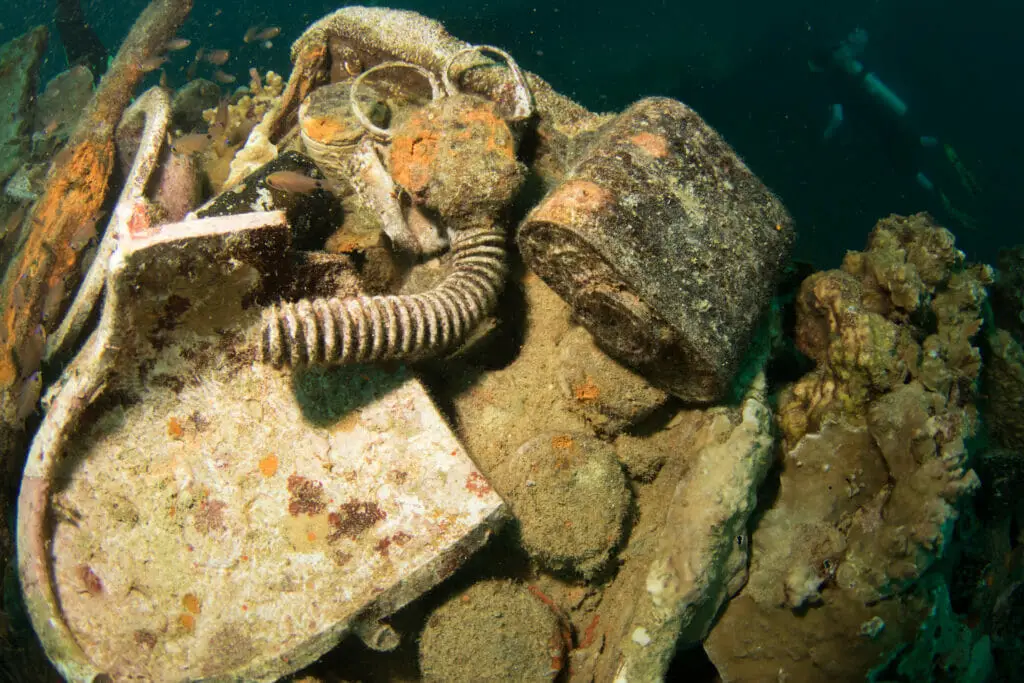
The Mystery Behind the Metal
What we do know: this ship was likely sunk during Operation Desecrate One in March 1944. Its forward section bears signs of an explosion, possibly from an internal detonation. No official records confirm its name, but it’s believed to have been a coastal freighter transporting military supplies and equipment.
The wreck lies nearly upright, with a slight list to port, at depths ranging from 15 to 35 meters—making it an ideal site for recreational divers with basic wreck experience.
What It’s Like to Dive the Helmet Wreck
From the very start of the dive, you’re greeted with a powerful sense of history. The ship’s bow is twisted and torn open, likely from a munitions explosion, offering an immediate look into the cargo holds.
Inside the wreck, divers can find:
Dozens of steel helmets, stacked like they were just unloaded
Gas masks, many still surprisingly intact
Ammunition boxes
Depth charges, carefully lined in racks (do not touch!)
Sake bottles, jars, medical vials, and crates of ceramic goods
These artifacts give the Helmet Wreck an almost museum-like quality—except you’re swimming through it instead of walking past glass.
There are open cargo holds and hatches, making it relatively easy to explore. The structure is tight in some places but not claustrophobic, and for divers with good buoyancy control, it’s an incredibly rewarding dive.
The stern holds an anti-aircraft gun and damaged deck gear, with scattered debris leading out onto the sandy bottom.
A Perfect Blend of Wreck and Reef
What makes this wreck truly special is how alive it’s become. Over the decades, corals have colonized the hull and railings, sponges have crept into the cracks, and anemones now dance on the decks. It’s one of the best places in Palau to see how quickly life returns to even the darkest moments in history.
Expect to see:
Lionfish hovering around the structures
Nudibranchs crawling across encrusted steel
Shrimp, lobsters, and eels peeking out of hatches and vents
Hard corals taking over the bow and stern
Schools of fish swirling around the mast
Underwater photographers especially love the Helmet for its light-and-shadow contrasts, tight composition options, and macro life tucked into every corner.
Dive Conditions and Tips
Depth: 15–35 meters
Visibility: 8 to 15 meters, typically lower than outer reefs due to the harbor location
Currents: Calm and manageable
Skill Level: Intermediate; excellent for divers new to wrecks
Best For: Photography, artifact spotting, historical exploration
This is one of those dives where you want to go slowly. Take your time in the holds. Look closely. The Helmet Wreck rewards curiosity. Every dive brings something new to notice—an inscription on a bottle, a rusted valve half-buried in sponge, or the quiet weight of history surrounding you.
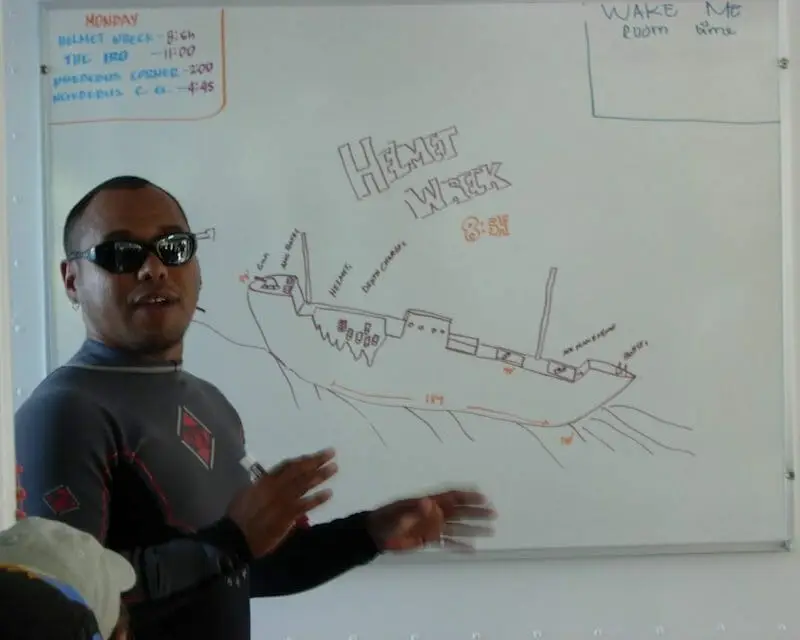
Chūyō Maru – The Lionfish Wreck
Some wrecks feel imposing. Others feel mysterious. The Chūyō Maru feels alive. From the moment you descend, you’re surrounded by movement—dozens of lionfish floating like silent sentries, soft corals swaying with the current, and bubbles trailing upward past steel structures wrapped in sponge and sea fan.
This 2,100-ton Japanese merchant freighter sits upright on a sandy slope in Malakal Harbor. She’s relatively small compared to giants like the Iro or Amatsu Maru, but what she lacks in size, she more than makes up for in character. The Chūyō Maru is an intimate, colorful, and beautifully preserved wreck that many divers call their favorite.
History in the Shadows
The Chūyō Maru likely met her fate during the American air raids of March 1944. Like many Japanese ships in the harbor, she was attacked from the air and sent to the bottom. Unlike some of her larger counterparts, she remained almost perfectly intact.
Resting between 33 and 38 meters, this wreck lies upright with a prominent bow, a distinguishable bridge structure, and open cargo holds—perfect for exploration. Time has been kind to her. Much of the deck gear, pipework, and even navigation equipment remains in place.
What It’s Like to Dive the Chūyō Maru
As you descend onto the wreck, the first thing you’ll notice is the fish. Lots of lionfish—everywhere. They gather in the holds, float above the deck, and seem to hover in formation beneath the overhangs. It’s no wonder divers started calling this the “Lionfish Wreck.”
The second thing you’ll notice? Color. This wreck is drenched in it.
Pink, purple, and orange soft corals flow over the railings
Sponges and whip corals reach from the sides
The deck is textured with both coral and mechanical remnants—winches, valves, and piping systems
There’s a large deck gun at the stern, still mounted and aimed skyward. Near the bridge, you’ll find collapsed metal grates and access hatches leading into the lower compartments. With proper training and lighting, limited penetration is possible—though many divers find the exterior details just as satisfying.
Photographers especially love this dive for its moody lighting and macro opportunities. The contrast of soft corals against rusted metal, paired with ever-present lionfish, makes for unforgettable compositions.
Marine Life Abounds
The Chūyō Maru is absolutely teeming with life. Beyond the lionfish, you’ll likely spot:
Moray eels and cuttlefish in the nooks and shaded corners
Pipefish hiding in coral fans
Cleaner shrimp, crabs, and lobsters in the hull crevices
Surgeonfish, angelfish, and other reef species swarming the deck
It’s a thriving ecosystem that feels more like a living reef than a war grave—and that’s part of what makes it so powerful.
Dive Conditions and Tips
Depth: 33–38 meters
Visibility: Typically 10–20 meters
Current: Minimal to none
Skill Level: Advanced (due to depth)
Recommended: Bring a dive light for inside holds and shaded areas
Photo Tip: Use a wide-angle lens and pay attention to ambient light—this wreck is magic in the right shadows
The Chūyō Maru is a hauntingly beautiful reminder of how the ocean reclaims even the hardest steel. It’s a dive that offers both historical reverence and full sensory immersion—and it’s one you won’t want to do just once.
Teshio Maru – The Channel-Side Giant
Lying just off one of Palau’s natural channels, the Teshio Maru is a beautifully intact and lesser-known Japanese freighter that rewards divers with open structure, vivid marine life, and a sense of quiet grandeur.
She doesn’t get as much attention as her sisters in the lagoon, but that’s part of her charm—you’re likely to have this one all to yourself.
This 114-meter cargo vessel was part of Japan’s wartime logistics fleet and met her end like so many others during Operation Desecrate One.
She now rests at a depth of 10 to 30 meters, making her one of Palau’s most approachable wreck dives, especially for those who want extended bottom time without pushing into technical limits.
An Underwater Monument to Utility and War
What makes the Teshio Maru so enjoyable is how open and well-preserved her structure is. She sits upright, slightly canted to port, with her bow facing out toward deeper water and her stern nestled into a sand slope closer to the reef wall.
Diving from the bow, you’re immediately greeted by an impressive deck gun, still mounted and surrounded by coral. The forward cargo holds are wide open—ideal for safe, natural light exploration. Pipes, valves, and railings remain in place, offering fascinating photo ops and texture everywhere you look.
As you drift toward midship, you’ll pass cranes, hatches, and engine components, many overtaken by soft corals. Penetration is possible through open hatches and broken hull panels, though most divers enjoy circling the exterior and taking in the full silhouette.
A Living Reef with a Front-Row Seat to the Channel
Thanks to its proximity to the channel, the Teshio Maru is blessed with regular water movement, which brings nutrients, corals, and pelagic life. It also means the site is constantly shifting in visibility and marine energy. Slack tide is the best time to dive here, but even during light current windows, the dive remains enjoyable.
Marine life here includes:
Butterflyfish, sergeant majors, and angelfish darting along the deck
Lionfish, nudibranchs, and pipefish sheltering in shaded areas
Reef sharks, barracuda, and jacks occasionally cruise by from the nearby drop-off
And an ever-changing mix of macro life tucked among the corals and wreckage
The blend of reef species and open-water visitors makes this one of the more biologically dynamic wreck sites in the region.
Dive Conditions and Tips
Depth: 10–30 meters
Visibility: 10–25 meters (best on incoming tide)
Current: Can be moderate—plan for slack tide
Skill Level: Suitable for intermediate to advanced divers
Recommended: Bring a dive light for inspecting compartments and coral shelves
Photo Tip: Use natural light around midship for soft coral textures; great for wide-angle lenses
Teshio Maru is the kind of wreck that sneaks up on you. At first glance, it seems straightforward—but the more you explore, the more you discover. It’s a wreck that rewards curiosity, and one that’s perfect for slow, thoughtful dives.
Palau Plane Wreck Diving: Submerged Aircraft from WWII
Jake Seaplane: A Shallow and Accessible WWII Dive
Just a short boat ride from Koror, resting gently in only 15 meters of water, is one of Palau’s most photographed and beginner-friendly WWII wrecks: the Jake Seaplane.
Unlike the massive, coral-crusted freighters elsewhere in the lagoon, this dive is delicate, peaceful, and surprisingly emotional—an aircraft frozen mid-flight, preserved by the sea for over 80 years.
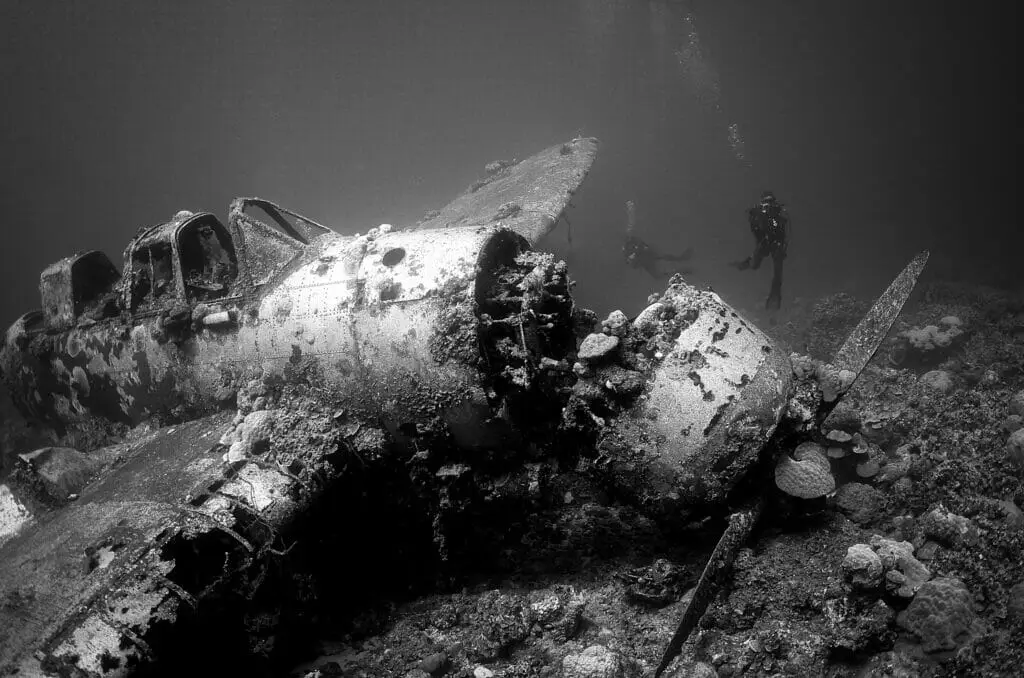
Image credit: Janic Carter / Scuba chick photography
Corsair Fighter: A Deep Dive for Advanced Wreck Divers
Hidden in the deeper waters of Palau’s inner reef is a dive that feels less like exploration and more like discovery. The Corsair Fighter Wreck isn’t a well-known site with moorings and crowds—it’s a solitary warbird resting quietly on a sandy bottom, with no shipwrecks or debris around. Just one aircraft. One story. And one powerful dive.
The Plane and Its Legacy
The Vought F4U Corsair was one of the most formidable fighter planes of WWII. Known for its distinctive gull-wing design and powerful engine, the Corsair saw extensive action in the Pacific Theater, flown by both U.S. Navy and Marine Corps pilots.
Palau’s Corsair isn’t surrounded by drama or destruction. There’s no wreckage field or battle-scarred fuselage. It lies alone in nearly perfect condition, with its propeller partially buried and wings still extended. Most striking of all: the cockpit is open.
No one knows for certain what caused this Corsair to ditch. Some speculate engine failure or fuel exhaustion; others believe it may have been forced to land during a patrol gone wrong. One thing is clear—this was a controlled landing. The pilot survived and was likely rescued.
That’s part of what makes this dive so intimate: it’s not a grave. It’s a story with a pilot who made it home.
What It’s Like to Dive the Corsair
You descend through blue water for a good 30 meters before the sand appears, and then—suddenly—it’s there. A single aircraft resting peacefully in the open, with no reefs or structures nearby. The moment feels theatrical. Surreal.
The plane itself is astonishingly well-preserved:
Wings are intact and folded outward, now covered in marine growth
The engine cowling and propeller are clearly visible, the blades partially embedded in sand
Cockpit is open, stripped of glass but framed with sea fans and sponge
The tail section is upright, with identifying markings weathered but visible in places
There’s something deeply human about hovering over the open cockpit. You can almost picture the pilot climbing out and swimming away.
Marine Life and Mood
Because the wreck is isolated on a sandy patch, it attracts marine visitors rather than residents:
Garden eels and gobies populate the sand nearby
Octopuses and shrimp often hide in the engine or beneath the wings
Surgeonfish and jacks occasionally pass through, investigating the strange silhouette
Sponges, soft corals, and fans have begun creeping up the wings and fuselage
But what makes this dive special isn’t just the life—it’s the mood. It’s quiet. Peaceful. Almost sacred. The isolation, the depth, and the stillness make this dive feel personal.
Dive Conditions and Tips
Depth: 30–40 meters
Visibility: Typically excellent (20–30 meters)
Current: Usually minimal, but varies by tide
Skill Level: Advanced (due to depth)
Recommended: Nitrox to extend bottom time
Photography Tip: Shoot wide-angle from a low angle to capture the Corsair’s iconic profile
This isn’t a dive you rush. The Corsair is best enjoyed slowly, taking in the details, imagining the pilot’s story, and feeling the silence. It’s not just a wreck. It’s a moment in time, perfectly preserved beneath the sea.
Do You Need Advanced Certification for Palau Wreck Diving?
The short answer? Not always.
Palau offers a wide range of wreck diving experiences, from shallow plane wrecks perfect for beginners to deeper, more technical shipwrecks that demand advanced training.
Entry-Level Wrecks for Recreational Divers
If you’re a certified Open Water diver, there’s still plenty to explore. Sites like the Jake Seaplane rest in just 15 meters (50 feet) of water, with minimal current and excellent visibility—ideal conditions for your first wreck dive.
These sites offer a great introduction to the history and marine life that make Palau’s wrecks so iconic, without requiring additional certifications.
When Advanced Certification Is Recommended
Wrecks like the Iro Maru, Amatsu Maru, and Chuyo Maru lie at greater depths—typically between 25 and 40 meters (80–130 feet). To explore these safely and responsibly, an Advanced Open Water certification is strongly recommended.
Many divers also use Enriched Air Nitrox to extend bottom time at these depths.
If you’re planning to enter the wrecks (penetration), you’ll need specialized wreck diving training, good buoyancy control, and a reliable dive light. Some interiors contain silt, narrow passageways, or limited visibility, so diving with an experienced guide is essential.
Dive with Confidence
At Palau Dive Adventures, our dive guides are not only certified and experienced—they’re also passionate storytellers who bring each wreck to life with context and care.
Whether you’re taking your first plunge into history or you’ve logged hundreds of dives, we’ll help tailor the experience to your comfort level.
And if you’re curious about some of Palau’s more exhilarating reef dives—where currents, sharks, and reef hooks come into play—check out our guide to reef hook diving in Palau to see how this unique skill adds a whole new dimension to your underwater adventures.
Pro Tip: Please let us know your certification level when booking—we’ll ensure you’re matched with the right sites and guides to maximize your dive experience.
From Steel to Sanctuary: Marine Life on Palau’s WWII Wrecks
One of the most magical aspects of wreck diving in Palau is seeing how nature has transformed instruments of war into thriving underwater ecosystems. Over the decades, each wreck has become its own reef—teeming with color, movement, and life.
The steel hulls, once sleek and menacing, are now softened by corals. Deck guns bloom with sea fans. Cargo holds shelter lionfish, and twisted beams are carpeted in sponges. These wrecks aren’t just monuments to history—they’re part of Palau’s reef system now.

A New Kind of Reef
The moment a wreck hits the seafloor, the transformation begins. In Palau’s nutrient-rich waters, coral polyps settle quickly on exposed steel.
Fish arrive soon after—first the curious, then the permanent residents. Over the years, entire communities form. Today, every wreck is a fully functional habitat.
What You’ll See
Here’s a taste of what divers commonly encounter on and around Palau’s WWII wrecks:
🐠 Reef Fish Galore
Clownfish dancing in their anemone homes near railings and cracks
Angelfish, butterflyfish, and surgeonfish weaving through coral-covered structures
Fusiliers, snapper, and damselfish gathering in schools around masts and cargo holds
🐙 Macro Heaven
Nudibranchs in all shapes and colors crawling along beams and portholes
Shrimp and cleaner stations tucked inside gun barrels or around propellers
Pipefish, gobies, and tiny crabs camouflaged against encrusted machinery
🦑 Octopus and Cephalopods
Octopuses and cuttlefish hiding inside compartments, blending into rusted metal
🦁 Lionfish and Scorpionfish
On some wrecks—especially the Chūyō Maru—lionfish are everywhere. Hovering, hunting, hiding in shadows. They’ve made these structures their fortress.
🦈 Larger Visitors
Reef sharks occasionally cruise past the deeper wrecks like Teshio or Amatsu Maru
Barracuda and jacks patrol the edges of the wrecks, especially near drop-offs
Turtles are seen occasionally, resting or feeding on sponge-covered railings
🌿 Hard and Soft Corals
Black coral bushes, especially on deeper wrecks like Amatsu Maru
Sea fans, whip corals, and sponges wrapped around railings, cranes, and decks
Giant clams embedded in hull openings or growing along the seabed nearby
The Magic of Contrast
There’s something deeply emotional about watching vibrant marine life take over the skeletons of war. You’ll hover over a bomb rack, only to find a nudibranch crawling across it. You’ll shine your torch into a former gun turret and see a shrimp nursery instead of ammunition.
This is the essence of wreck diving in Palau: war machines reclaimed by nature. Beauty layered over destruction. Life is continuing where once there was chaos.
When to Dive Palau’s WWII Wrecks: Best Time and Conditions
Palau is a year-round dive destination—but if you’re here to explore WWII wrecks in their best light, timing and conditions make all the difference. Whether you’re descending on the Iro’s coral-covered gun turrets or peering into the engine room of the Amatsu Maru, visibility, current, and sea conditions can dramatically shape your experience.
🌤 Best Time to Dive Wrecks in Palau
Dry Season: December to March
This is prime time for wreck diving. Clear skies, calmer seas, and visibility often pushing 30 meters make this season ideal for photography, deeper dives, and consistent boat access to key wreck sites.
Shoulder Season: April to June / October to November
Still very good. Occasional showers may roll through, but dive conditions often remain favorable. Fewer tourists mean you may have popular wrecks all to yourself.
Rainy Season: July to September
Expect more wind, swell, and surface chop, especially on outer reefs. That said, many of Palau’s wrecks lie in sheltered lagoons or harbors—so conditions can still be quite manageable. Visibility may drop slightly, but diving is rarely canceled outright.
🌊 Visibility
Average: 15 to 30 meters
Best Sites: Jake Seaplane, Corsair, and Iro Maru
Tips: Aim for morning dives when the water is calmest and sediment hasn’t been stirred up
🌡 Water Temperature
Ranges from 27°C to 30°C (81°F to 86°F) year-round
Most divers are comfortable in a 3mm wetsuit; some go with less in summer months
🌬 Currents
Generally mild at most wreck sites, especially those in the inner lagoon (Helmet Wreck, Jake Seaplane, Iro Maru)
Teshio Maru and other channel-side wrecks can see stronger currents—dive them at slack tide
🌡 Recommended Gear & Dive Planning Tips
Nitrox: Strongly encouraged for deeper wrecks like Iro, Amatsu, Chūyō, and Corsair—more bottom time, more exploration
Dive Light: A must for holds, bridges, and interior compartments—even shallow ones
Gloves: Optional, but helpful for grip (just be careful not to disturb coral or artifacts)
Dive Computer with Deco Planning: Especially important for dives approaching 30+ meters
Surface Marker Buoy (SMB): Always a smart idea in Palau, even for inner-lagoon sites
🚤 Boat Access
Most of Palau’s wrecks are just a short boat ride from our base in Koror—usually between 5 and 30 minutes, depending on the site and sea conditions. At Palau Dive Adventures, we specialize in wreck diving that’s both safe and deeply immersive.
Our guides aren’t just dive pros—they’re passionate storytellers who know the history behind every wreck, every artifact, and every coral-covered gun turret you’ll see underwater.
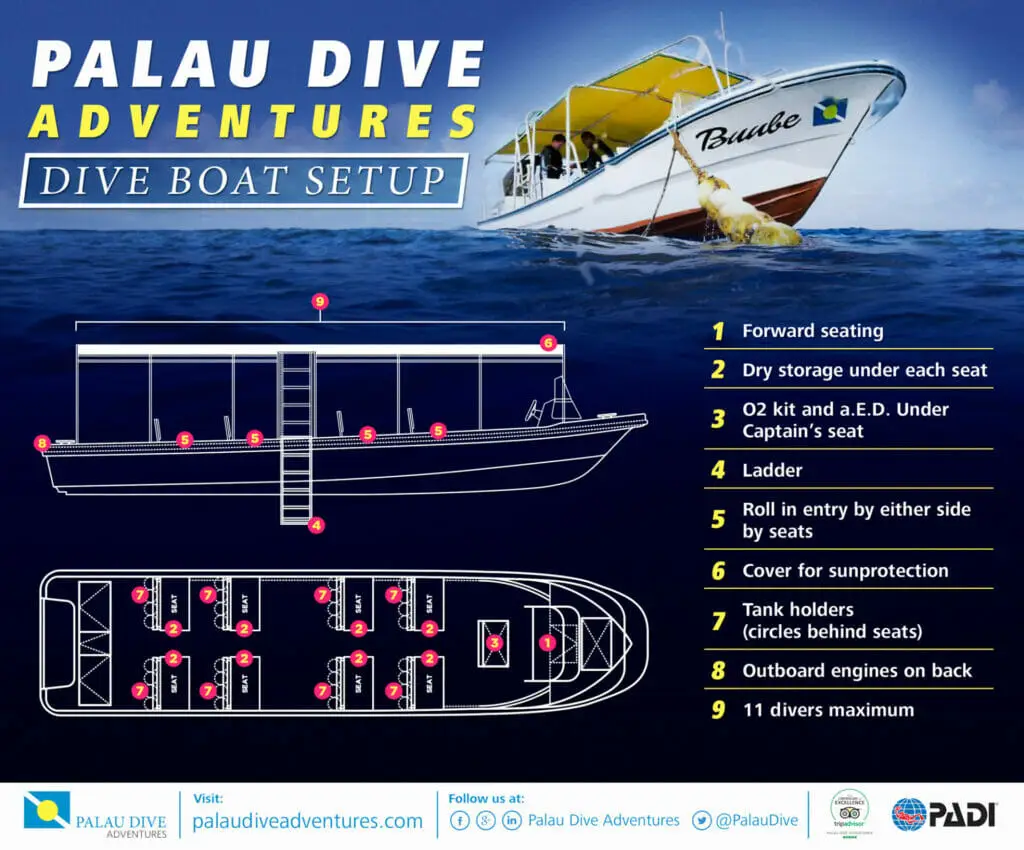
Responsible Diving: Preserving Palau’s WWII Dive Sites
Palau’s WWII wrecks are more than just steel and coral—they’re silent witnesses to one of the most consequential conflicts in human history.
For many divers, visiting these sites is emotional. Some are war graves. Others hold personal artifacts from lives interrupted. And all have become part of Palau’s natural and cultural heritage.
Palau takes preservation seriously—and as divers, so should we.
🇵🇼 Palau’s Commitment to Preservation
Palau has long been a leader in ocean conservation, and its wrecks are no exception. While not all wrecks are formally protected by law, many are monitored and treated as part of the nation’s broader marine heritage.
Some key initiatives include:
- Project Recover: An international team working with Palauan authorities to locate and document aircraft and crew still missing from WWII.
- Community Awareness: Local dive shops and guides actively educate divers on respectful wreck interaction.
- Cultural Reverence: Palauan culture emphasizes deep respect for history, ancestors, and the ocean. Wrecks are seen not just as dive sites, but as part of that ancestral seascape.
🛑 What Not to Do on a Wreck Dive
Please don’t:
- Touch or take anything. That bottle, helmet, or shell casing? It belongs to history—not your gear bag.
- Disturb marine life. That lionfish isn’t just cool-looking—it lives here.
- Enter wrecks if you’re not trained. Silt-outs, sharp edges, and narrow spaces can quickly turn dangerous.
- Stand or kneel on coral-covered surfaces. Even a single fin kick can damage decades of growth.
✅ What You Should Do
- Practice excellent buoyancy: Wreck interiors and fragile growth require precision.
- Use a light for interior sections: Not just for visibility—but to avoid accidental damage.
- Ask your dive guide about history: Many know incredible stories you won’t find in books.
- Treat the wreck as sacred space: Even if it’s not officially a grave, dive as if someone’s memory lives there.
A Living Legacy
What makes Palau’s wrecks extraordinary is that they’re not frozen in time.
They’re evolving—growing, teeming with life, and slowly becoming part of the reef itself.
As divers, we have the privilege of visiting these places. But with that privilege comes responsibility.
Dive softly. Look closely. Leave it better than you found it.
How Palau Compares to Other WWII Wreck Diving Hotspots
The world is full of legendary wreck diving destinations. From the ghost fleets of Micronesia to the war-torn waters of the Philippines, divers have no shortage of sunken history to explore.
So how does Palau compare? The answer? Exceptionally well.
Palau offers a rare blend of historical significance, marine biodiversity, crystal-clear visibility, and diverse wreck experiences—all within a compact, accessible area.
Let’s break it down:
🇲🇵 Chuuk Lagoon (Truk) – The Giant Fleet
The Case For: Chuuk is often considered the king of wreck diving. Operation Hailstone in 1944 left behind more than 40 sunken warships and hundreds of aircraft.
The Experience: Deep, expansive wrecks, often penetrable, with vast cargo holds and dramatic war damage.
The Challenge: Many sites are below 30m; currents can be strong. Visibility varies and infrastructure is more limited.
Palau’s Edge: Easier access, better overall dive variety (reefs, sharks, mantas), and more vibrant coral growth on the wrecks.
🇵🇭 Coron Bay, Philippines – Shallow Shipwreck Playground
The Case For: A stunning array of Japanese WWII wrecks in relatively shallow water, perfect for beginners and underwater photographers.
The Experience: Many wrecks sit at 15–25 meters with good coral coverage and beginner-friendly swim-throughs.
The Challenge: Lower visibility and heavier boat traffic.
Palau’s Edge: Clearer water, better-preserved wrecks, richer biodiversity, and fewer crowds.
🇲🇭 Bikini Atoll – The Nuclear Ghost Fleet
The Case For: Home to warships sunk during U.S. nuclear testing, including the USS Saratoga aircraft carrier and the legendary Japanese battleship Nagato.
The Experience: Technical diving nirvana—deep, powerful, and eerie.
The Challenge: Requires advanced/technical training, remote access, and careful planning.
Palau’s Edge: Accessible to recreational divers, warm water, diverse marine life—and no special tech certifications required.
🇸🇧 Solomon Islands – Remote and Raw
The Case For: Scattered across dozens of islands are shipwrecks, downed aircraft, and sunken tanks—many still undiscovered.
The Experience: Off-the-beaten-path diving with real exploration vibes.
The Challenge: Remote locations, limited infrastructure, and more difficult travel.
Palau’s Edge: Easier logistics, richer marine life, better-developed dive tourism.
✅ Palau’s Sweet Spot:
- Dozens of wrecks (ships & planes)
- Accessible depths for recreational divers
- Exceptional visibility
- High coral and marine biodiversity
- Warm, calm conditions year-round
- Seamlessly combined with world-class reef, drift, and shark diving
In short: Palau doesn’t just offer great wreck diving—it offers wreck diving with extras. Whether you’re coming for the Iro or staying for Blue Corner, few places deliver such a complete diving experience.
Planning Your Wreck Diving Adventure to Palau
So, you’re ready to experience the sunken ships, warbirds, and living reefs of WWII-era Palau—now it’s time to make it happen.
Whether it’s your first time visiting or your fifth, a little preparation goes a long way toward making your wreck diving adventure seamless, safe, and unforgettable.
Here’s everything you need to know.
🛫 Getting to Palau
- Fly into Roman Tmetuchl International Airport (ROR) in Koror—the main hub for all dive trips.
- Connecting cities: Most routes go through Guam, Manila, Taipei, or Seoul.
- Tip: Book well in advance if visiting during dry season (Dec–Mar); flights and accommodations fill up quickly.
🧳 What to Pack
- C-Card & Logbook: Some wrecks require proof of experience or advanced certification.
- Dive Computer: Essential, especially for wrecks 30+ meters deep.
- Nitrox Certification Card: Strongly recommended—many wreck dives are deeper than 20 meters.
- Reef-Safe Sunscreen & Rash Guard: Even on boat rides, the sun is intense.
- Dive Light: A must for exploring inside holds, bridges, and engine rooms.
🧭 Where to Stay
- Koror is the hub for all diving activities, with a wide range of hotels, guesthouses, and resorts.
- Stay close to your dive operator’s dock or arrange daily transfers.
- Pro Tip: Book accommodations that offer secure gear storage and post-dive rinse stations.
🤿 Choosing a Dive Operator
Look for a dive shop that:
- Specializes in WWII wreck diving (not all do)
- Offers small group sizes or private guides
- Includes briefings with historical background (it brings the wrecks to life)
- Provides Nitrox, dive computers, and quality rental gear
- Maintains a strong commitment to conservation and respectful diving practices
Why Dive with Palau Dive Adventures?
We’re proud to be one of Palau’s top-rated dive operators—with over a decade of five-star reviews on Tripadvisor and Google. Divers from around the world consistently praise our personalized approach, passionate local guides, and deep knowledge of Palau’s WWII wrecks and marine ecosystems.
Whether you’re a history buff, wreck enthusiast, or first-time visitor to Palau, our team is dedicated to giving you an unforgettable and truly personal dive experience—one small group at a time.
💬 “Absolutely top-notch operation… They knew the history of every wreck we visited and made us feel like part of the crew.” – Tripadvisor review
Ready to see what makes us a diver favorite? Check out our reviews or come experience it for yourself.
How Many Days Should You Dive?
- 3 days minimum gives you time to explore multiple wrecks at varying depths
- 5+ days lets you mix in reef dives, Blue Corner, and even a Peleliu land tour
- Consider spacing out deeper wreck dives to allow for recovery and off-gas time
🛟 Health, Safety & Insurance
- Dive insurance (e.g., DAN) is highly recommended, especially when diving deeper wrecks
- Palau has a hyperbaric chamber located in Koror, offering peace of mind in case of emergency
- Stay hydrated, avoid alcohol between dives, and give yourself at least 18 hours after your last dive before flying
🧭 Bonus Tip: Combine Your Wreck Dives with Palau’s Other Wonders
Yes, the wrecks are incredible. But don’t leave without diving:
- Blue Corner – The wildest drift dive in Micronesia
- German Channel – Home to Palau’s manta rays
- Ulong Channel – With walls of lettuce coral and soaring sharks
- Mandarin Fish Lake – For that rare, vibrant flash of dusk-time mating rituals
Palau is a complete dive destination—wrecks are just the beginning.
FAQs About Wreck Diving in Palau
Yes—when done responsibly. Most wrecks are in protected waters with minimal current, and experienced local guides lead all dives. As always, follow briefings, stay within your limits, and don’t penetrate wrecks unless you’re trained and equipped to do so.
Absolutely not. Removing items from wrecks is illegal and unethical. Many are war graves or culturally significant heritage sites. Take only photos, leave only bubbles.
Between 27°C and 30°C (81°F–86°F) year-round. A 3mm wetsuit is perfect for most divers.
December to March (dry season) offers the best conditions—clear skies, calm seas, and excellent visibility. But Palau is diveable year-round, and many wrecks are in sheltered areas.
Yes! The Jake Seaplane is visible from the surface on calm days and makes a great snorkeling site for non-divers or surface intervals.
Not at all. One of Palau’s best-kept secrets is how uncrowded the wrecks are. You’ll often have the entire site to yourself—just you, your buddy, and 80 years of history.
Yes—and it’s highly recommended. Many of Palau’s WWII wrecks lie below 25 meters, and diving with Nitrox (enriched air) helps extend your bottom time while reducing nitrogen absorption for added safety.
At Palau Dive Adventures, we offer Nitrox for free to all certified Nitrox divers. It’s part of our commitment to making your dives longer, safer, and more enjoyable—at no extra cost.
If you’re not Nitrox certified yet, let us know—we can help you arrange training or guide you through optimal gas planning with air.
You can dive many of the wrecks with an Open Water certification, but Advanced Open Water, Deep, or Wreck Diver specialties will open up far more options and let you explore safely and confidently.
It’s one of the best places on Earth for both. Spend one day on sunken warships and the next drifting with sharks at Blue Corner. No compromise needed.



